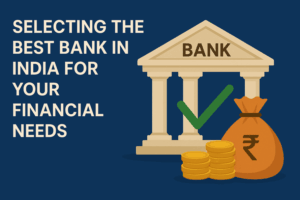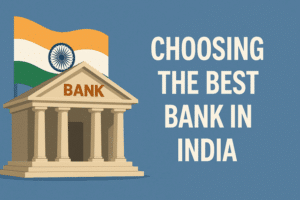
The Reserve Bank of India (RBI), the central bank of India, invokes Prompt Corrective Action (PCA) to ensure the stability of the country’s banking system. The RBI generally uses PCA when a bank’s performance falls below a certain level. This stops the bank’s performance from getting worse. It also encourages them to take the necessary steps. That’s why the PCA system keeps customers safe and the bank stable. Let’s understand what is PCA in banking in detail.
When does the RBI invoke prompt corrective action?
If a bank’s situation changes significantly compared to the set standards, like Capital Adequacy Ratio (CAR), Asset Quality, Profitability, or Leverage, the RBI uses PCA in banking. There are levels or signals for each of the factors given. For example, if a bank’s financial numbers are bad, the RBI could limit dividend payments and the opening of new branches.
• Capital Adequacy Ratio (CAR)
The capital adequacy ratio (CAR) is a useful measure to compare a bank’s capital to the total amount of risk it faces. It is found by dividing the bank’s capital by the risk-weighted assets. This significant test shows how well a bank can handle possible losses and protect clients’ money. According to PCA, the RBI sets a minimum capital-to-risk-weighted asset ratio, which is also known as CAR.
• Asset Quality
People often use the amount of non-performing assets (NPAs) to measure asset quality. This shows that a bank’s loan portfolio is healthy. If NPAs are unusually high, the bank’s assets aren’t making enough money because of bad loans and possible losses. If a bank has too many non-performing loans, the PCA system allows for action to be taken. The RBI can order the bank to stop issuing new loans and require it to set aside more money for unpaid assets.
• Profitability
Making money is also part of the PCA structure. Return on Assets (ROA) and other metrics are used to judge it. If a bank has a negative ROA or doesn’t make enough money over time, it means something is wrong. Having poor ROA means the bank’s cash is used up, and the business can’t handle losses anymore. As part of the PCA for banks, the RBI can limit some business activities, ask the bank for a plan to cut costs, or suggest that the bank join or consolidate with another bank to make it more successful.
• Debt Level/Leverage
You can determine how much debt or leverage a bank has by looking at its debt-to-equity ratio. This shows how much of the bank’s money comes from loans. A high leverage ratio means a bank has a lot of debt in its capital structure, which can have a negative impact. The RBI is also in charge of the leverage ratio under PCA. If the bank exceeds the cap, it will be asked to cut its debt. This might mean giving up more stock, selling a business that isn’t essential, or cutting its risk to get a better debt ratio.
What happens when the RBI places a bank under PCA
Now that you have a good understanding of what is PCA in banking, let’s understand what happens when the RBI places a bank under PCA.
When the RBI puts a bank on its PCA watch list, it limits it in two ways, and it must follow specific rules. No matter what, the apex bank can ask the bank in question to implement any of these changes:
- Ask the bank’s board to re-evaluate its business plan and determine whether the business line and activities are profitable.
- Tell banks they need to rethink their business plans and strategies to fix the problem, which could mean firing some employees.
- Instruct banks to examine their balance sheet estimates and determine their medium- to long-term viability.
- Some banks under PCA may be unable to hire more people or fill open jobs.
- Lastly, the RBI might let PCA banks spend money on capital projects that improve technology only. However, the amount spent on these projects must stay within the agreed-upon limits.
How do banks benefit from PCA?
Prompt corrective action may sound like bad news for a bank because the RBI imposes it. However, it can help banks deal with financial stress. Now that you know what is PCA in banking, you should understand that the RBI sets limits to ensure that things don’t get worse and become a full-on problem.
- PCA wants to fix a bank’s money problems before they worsen and cause a crisis. Early action like this saves investors and ensures the security of the banking system.
- The PCA system tracks key factors that help a bank’s financial health. RBI then fixes problems based on these assessments to restore normalcy.
- RBI monitors and limits the amount of loans PCA banks can give out, but it doesn’t completely stop them. This keeps risks under control while letting banks do their most important jobs.
- PCA banks aren’t allowed to open new lines of business. This will enable them to strengthen their current activities and improve their cash situation.
- In rare cases, the RBI may close down or join PCA banks that don’t follow the rules. Banks take these steps to protect the public interest and maintain trust in the banking system.
Should depositors be worried if their bank is on PCA?
As a general rule, bank customers need not worry. This preventive measure aims to identify risks early so that bank users can take the proper steps to fix them. And, despite what bank users may think, neither their savings nor the bank itself will be liquidated.
If the bank is put under remedial action, it won’t affect or limit normal banking activities. But because of the risk barrier band, the apex bank can impose limits on how far banks can grow, how much managers can be paid, or how much dividends they can give out.
How can banks get out of the RBI’s PCA list?
Banks can get out of the PCA system if they achieve the required levels of capital, asset quality, revenue, and other factors over time. Now that you know what PCA is in banking, remember that the RBI looks at banks’ progress and corrective measures undertaken to see if they can exit the PCA structure.
• Mergers and amalgamations
Considering mergers or amalgamations as a strategic move can be helpful for banks that are subject to PCA in banking, as it limits credit. RBI could force the weak bank to merge with a stronger bank to improve its capital structure, the quality of its assets, and its overall health. The merger can help the new bank by creating benefits, lowering costs, and making it more competitive.
• Bank Recapitalization
Another thing that banks often do under PCA is bank recapitalization. Recapitalization means putting more money into a bank to ensure it has enough capital to handle losses. The funds could come from the government or the bank’s owners. Through recapitalization, banks can improve their capital adequacy ratio, lower their level of debt, and boost market trust.
Why PCA?
RBI must take corrective actions on time, or banks may not have enough cash to cover the losses. These losses usually happen for internal reasons, like when businesses or institutions can’t pay back their loans, and external reasons, like when the economy slows down. In such a scenario, the RBI intervenes through the PCA system, allowing banks to clean up their businesses. This can help both banks and users who have deposited money in those banks.
Conclusion
Now that you know precisely what PCA is in banking, you should understand that PCA’s job is to fix the bank’s mistakes before they become so big that they cause a problem. The main way that PCA helps RBI fix a bank’s finances is by monitoring its key performance factors and making changes as needed.
FAQs
Q. What is the meaning of PCA in banking?
What is PCA in banking? PCA stands for Prompt Corrective Action. The Reserve Bank of India (RBI) set up this system to help banks having trouble with their finances.
Q. Which banks are under PCA currently?
Allahabad Bank, Bank of India, Corporation Bank, Bank of Maharashtra, Indian Overseas Bank, Central Bank of India, Dena Bank, IDBI Bank Limited, Oriental Bank of Commerce, UCO Bank, and United Bank of India were placed under PCA between 2017 and 2018. They were taken out of PCA after they improved their NPA levels and capital adequacy. check here







